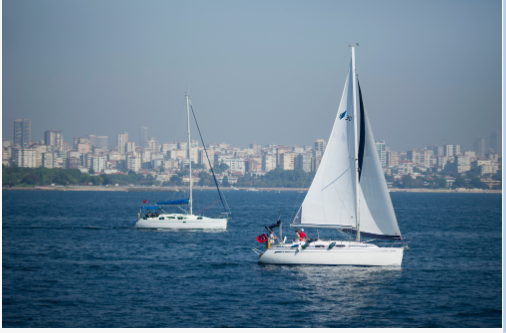A cruising asymmetrical spinnaker has emerged as a favored sail choice among cruising sailors seeking an efficient, user-friendly downwind sail that maximizes boat performance and simplifies handling. Unlike the traditional symmetrical spinnaker that requires a spinnaker pole and more crew involvement, the Multi-Purpose Spinnaker (MPS) is shaped like a large jib and tacked directly to the bow or a bowsprit. This design makes it significantly easier to set, gybe, and douse, which is especially beneficial for short-handed or bluewater sailors who prefer simplicity without sacrificing speed.
Design and Construction Features
Typically constructed from lightweight yet durable nylon fabrics such as Challenge sailcloth, the cruising asymmetrical spinnaker features an A2 tri-radial cut that strikes a balance between shape retention and strength. Utilizing computer-aided cutting ensures a precise fit with consistent panel sizing. Triple-stitched seams, radial corner patches, and webbed rings reinforce high-stress points such as the head, tack, and clew, providing durability against the constant strains of sailing. Color-coded luff and leech tapes help easily identify the correct orientation when hoisting or trimming the sail.
The broad foot and cambered shape produce powerful drive within apparent wind angles ranging from approximately 80 to 155 degrees. This makes it ideal for maximizing boat speed on broad reaches and running points of sail. Unlike symmetrical spinnakers, the Multi-Purpose Spinnaker (MPS) achieves effective wind capture without additional hardware, thanks to its tack connection directly to the bow or bowsprit.
Advantages for Cruising Sailors
For cruising sailors, the cruising asymmetrical spinnaker is a pivotal upgrade in terms of versatility and ease of use. The absence of a spinnaker pole simplifies rigging and reduces crew requirements considerably. Many asymmetrical spinnakers are used in conjunction with a spinnaker sock or sleeve, further easing deployment and retrieval, thus enhancing safety, especially when sailing short-handed.
Additionally, cruisers can often fly the asymmetrical spinnaker alongside a furling jib or genoa, broadening their downwind sail options without investing in extra gear. The sail’s forgiving shape adapts well to varying wind speeds and directions, making it suitable for various cruising conditions where the wind may shift or fluctuate. The combination of power and simplicity allows this sail to excel in both inshore races and longer offshore passages with ease.
Rigging and Handling Tips
Rigging a cruising asymmetrical spinnaker is noticeably simpler than for symmetrical models. Without a spinnaker pole, the rigging consists mainly of two sheets running aft to the cockpit — one used for trimming and the other for gybing. The sail is hoisted via a dedicated halyard and usually tacked to the bow pulpit, anchor roller, or retractable bowsprit.
Gybing with the asymmetrical sail requires merely releasing one sheet while trimming the other, as the sail passes smoothly in front of the forestay without the need to reposition a pole. This simplified process greatly reduces the physical demands and safety risks involved, making it ideal for single-handed or double-handed cruisers.
Choosing the Right Cruising Asymmetrical Spinnaker
Selecting the right Multi-Purpose Spinnaker (MPS) means matching sail dimensions and shape to the specific boat’s hull and rigging. Sailmakers offer various standard sizes that fit a wide range of boats, while custom designs maximize performance by tailoring shape, fabric, and finishing touches to the sailor’s needs. For example, medium-sized cruisers like the Catalina 27 often use sails around 35 feet in luff length, 33 feet in leech, and about 19 feet in foot length.
Fabric weight, panel layout, and reinforcements are optimized for cruising durability rather than racing weight savings, focusing on longevity and ease of use. Sail colors span the spectrum from solid vibrant hues to multi-color patterns and fluorescent options, enabling sailors to personalize their sails and increase visibility on the water.
Maintenance and Storage
Proper maintenance is essential to prolonging the Multi-Purpose Spinnaker’s (MPS) lifespan. After each use, rinsing the sail with fresh water helps remove corrosive salt deposits, while thorough drying before storage prevents mildew buildup. Folding or rolling the sail carefully preserves its shape and prevents creases, which can weaken fabric over time. Many sailors use dedicated sail bags for storing and transporting the spinnaker to protect it from UV damage and abrasion.
Regular inspections for wear, minor repairs, and ensuring clean storage conditions allow the sail to remain functional and vibrant for many seasons.
Expanded Benefits and Practical Uses
Apart from its ease of handling and performance boost, the cruising asymmetrical spinnaker lends itself well to various sailing scenarios. It offers more power in lighter air compared to a jib alone, which helps improve boat speed on downwind legs. Using it can turn potentially dull downwind runs into exhilarating, fast passages.
Moreover, because it can be set without complex rigging, the asymmetrical spinnaker encourages sailors to sail more confidently downwind, exploring points of sail that might be challenging with traditional spinnakers. This encourages safer cruising by reducing the likelihood of sail handling mishaps.
In terms of design, the flexibility of the asymmetrical allows for mounting on bowsprits — including retractable models — effectively extending the sail area forward of the hull and improving speed and control. This flexibility is beneficial both for racing sailors and long-distance cruisers.
Conclusion
The cruising asymmetrical spinnaker combines the power and allure of traditional spinnakers with modern simplicity and rigging ease. Lightweight, durable, and versatile, it fits a wide range of sailing styles, from competitive inshore racing around buoys to relaxed offshore cruising. By reducing rigging complexity and crew demands while maintaining excellent downwind performance, it has become an indispensable tool for today’s savvy cruising sailor.
Using a Multi-Purpose Spinnaker (MPS) enhances sailing pleasure and safety—empowering sailors to confidently fly a powerful, beautiful sail that accelerates progress to their next destination with style and efficiency.









